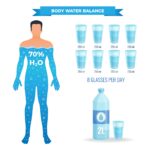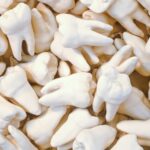Body water and body fluids

Introduction
- In an average young adult male ,
(i) 7% of body weight is mineral. (ii) 15% is fat.
(li) 18% is protein and related substances. (iv) 60% is water, called total body water
(TBW). - TBW is about 10% lower in young females due to relatively greater amount of adipose tissue (subcutaneous fat)
- In infants TBW is 65-75% of body weight.
Distribution of Total Body Water
The distribution of the total water in the body is as given in Table
| Compartment | volume (L) | body weight % | body water % |
| Total Body Water | 42 | 60 | 100 |
| a. Extracellular Fluid | 14 | 20 | 33 (1/3 TBW) |
| b. Intracellular Fluid | 28 | 40 | 67 (2/3 TBW) |
A. Extracellular Fluid Compartment
The extracellular fluid is contained in the spaces outside the cell. The ECF compartment includes: plasma, interstitial fluid and transcellular fluid (Table 3.2).
- Plasma is the fluid portion of the blood. It represents 25% of the ECF. Its volume can be calculated from blood volume and packed cell volume (PCV) as under:
Plasma volume (L) = Blood volume (L) x {100 – Hematocrit (PCV)}/100
Blood volume: Plasma and blood cells which fill the vascular system is called blood volume. It is approx. 80 mL/kg of body weight or 8% of the total body weight. - Interstitial fluid: That part of ECF which is outside the vascular system is called interstitial fluid.
It surrounds all cells except blood cells and includes lymph. It is in constant motion throughout the body and is transported rapidly in the circulating blood. Lymph constitutes 2-3% of the total body weight. - Transcellular fluid: Transcellular fluid represents fluid in the lumen of structures lined by epithelium.
It includes digestive secretions; sweat; cerebrospinal fluid (CSF); pleural, peritoneal, synovial, intraocular (aqueous and vitreous humours) and pericardial fluids, bile and luminal fluids of the gut, thyroid and cochlea. Transcellular fluid volume is relatively small, about 1L = 15 mL/kg of body weight (1.5% of body weight)
Important Note
The normal cell function depends upon the constancy of the fluid that forms the actual immediate environment of the cells. For this reason blood is called the internal environment of the body or millieu interieur.
B. Intracellular Fluid Compartment
The intracellular fluid is the fluid contained within the body cells. This is larger of the two major fluid compartments. The volume of the ICF compartment varies.
Ionic Composition of Body Fluids
Characteristic features
- Ions constitute approx. 95% of the solutes in the body fluids .
- The distribution of electrolytes in various body compartments differs markedly. However, the sum of the concentrations of the cations equals the sum of the concentrations of the anions in each respective compartments making the fluid in each compartment electrically neutral.
- Na+, Ca2+, Cl– and HCO3– are largely extracellular; whereas, K+, Mg2+, organic phosphates (PO43-, and proteins (prot–) are predominantly present in the ICF.
- Essentially all of the body K+ is in the exchangeable pool, whereas only 65%-70% of the body Na+ is exchangeable. Only the exchangeable solutes are osmotically active.
- Almost all of the body Ca2+ (in bone) and most of the body Mg2+ (in bone and cells) are non-exchangeable.
| Ions | ECF | ICF |
| Cations | ||
| Na+ | 145 | 12 |
| K+ | 5 | 155 |
| Mg2+ | 2 | 15 |
| others | 2 | 2 |
| Total cations | 154 | 184 |
| Anions | ||
| Cl– | 110 | 8 |
| HCO3– | 27 | 8 |
| Phosphate ( PO43-) | 2 | 90 |
| Proteins (prot–) | 15 | 60 |
| others | – | 18 |
| Total anions | 154 | 184 |
| Total Ions | 308 | 368 |
Units to measure concentration of solutes
The number of molecules, electrical charges or particles of a substance per unit volume of a particular body fluid are frequently expressed in moles, equivalents or osmoles respectively.
A. Moles
The mole is the standard unit to express the amount of substances in the SI unit system. A mole is the gram-molecular weight of a substance, i.e. the molecular weight of the substance in grams. Each mole (mol) consists of approx. 6 × 1023 molecules. Thus, 1 mole of KCI = 39 + 35.5 g = 74.5 g (i.e. sum of atomicmasses of all the atoms in the molecule).
The millimole (mmol) is 1/1000 of a mole.
Therefore, 1 mmol of KCI = 74.5 mg.
- The concentrations of two different substances on the basis of number of grams per litre of solution does not indicate how many molecules of each compound are present. Therefore, concentrations in units of grams per litre are often used when the chemical structure of the solute is unknown.
- When the structure of a molecule is known, concentrations are expressed as moles per litre.
This provides a unit of concentration based upon the number of molecules of the solute in solution. Thus, a solution containing 74.5 g of KCl in one litre of solution is said to be one molar (1M or 1 mol/L) solution of KCI. - Since, 1 mole of any molecule have the same number of molecules (6 × 1023), therefore 1 M solution of KCI contains the same number of solute molecules per litre as 1 M solution of glucose or any other substance.
B. Equivalents
- The equivalent is the standard unit to express the solutes in the body which are in the form of charged particles. One equivalent (Eq) is 1 mole of an ionized substance divided by its valency. One mole of KCI dissociates into 1 Eq of K+ and 1 Eq of Cl–. One Eq of K+ = 39 g/1 = 39 g; but 1 Eq of
Ca2+ = 40 g/2 = 20 g. The milliequivalent (mEg)is 1/1000 of 1 Eq. - The normality (N) of a solution is the number of gram equivalents in 1 litre. Therefore, 1 N solution
of hydrochloric acid contains 1 + 35.5 g/L = 36.5g/L.
C. Osmoles
- The amount of concentrations of osmotically active particles are usually expressed in osmoles (osm).
One osmole equals the gram molecular weight (i.e. one mole) of the substance divided by the number of free moving particles each molecule liberates in solution. The milliosmole (mosm) is 1/1000 of 1 osm.
As 1 osmole = Gram molecular weight (i.e. one mole) of a substance / Number of free movable particles each molecule liberates in solution . Therefore,- (i) if a solute is a non-ionizing compound (e.g. glucose), then one osmole is equal to 1 mole of solute particle. Thus, 1 molar solution of glucose has a concentration of 1 osm (1 osmole per litre).
- (ii) if the solute ionizes and forms an ideal solution, each ion is an osmotically active particle. Thus, in 1-molar solution of NaCI, NaCI would dissociate into Nat and Cr ions, so that each mole in solution would supply 2 osmoles of solute per litre of solution.
- Similarly, one mole of CaCI2 , would dissociate into Ca2+, Cl– and Cl– supplying 3 osmoles.
- The number of osmoles per litre of solution is called osmolarity, e.g. plasma; whereas the number of osmoles per kilogram of solvent is osmolality.
- Osmotically active substances in the body dissolve in water. As the density of water is 1, therefore, osmolal concentration is expressed in osmoles per litre (osm/L) of water.
Important Note
Osmolarity is affected by the volume of the various solutes in the solution and the temperature, while osmolality is not.
D. Concept of pH and H+ Concentration
- H+ concentration of various body fluids is expressed in two different ways either directly as [H+] or indirectly as pH .
pH refers to the negative logarithm of the [H+).
The relation between [H+] and pH can be expressed
as:
(i) pH = 10910 1/[H+]- ](ii) pH = -10910 [H+]
- pH and [H+] are inversely related. Another advantage of the pH concept is that when the pK of a buffer system is known, it is immediately possible to determine the effective pH range of the buffer,
where K = the ionization or dissociation constant.
Therefore, pK = negative log of K (-log K) and is
equal to the pH at which half of the acid molecules are dissociated and half are undissociated. - Blood pH always refers to plasma pH (7.4), the range of [H*] that is compatible with life is
20-126 nEq/L = pH of 7.7 to 6.9.
Optimal pH range for blood at which human body functions properly is 7.35 to 7.45 (7.4 + 0.05).
Clinically, blood pH < 7.35 is referred to as acidosis, and blood pH >7.45 as alkalosis
| pH | [H+] nmol/Lor nEq/L= 10-9 mol/L | |
| 8.0 | maximum alkaline urine | 10 |
| 7.70 | of plasma (severe alkalosis) | 20 |
| 7.41 | (arterial blood) | |
| 7.40 | (plasma) | 40* |
| 7.38 | (mix venous blood) | |
| 7.30 | (CSF) | 50 |
| 7.20 | (RBC) | |
| 7.10 | (ICF) | 80 |
| 7.00 | (pure water) ‘neutral’ | 100** |
| 6.90 | of plasma(severe acidosis) | 126 |
| 6.00 | (normal urine) | 1000 |
| 4.50 | (urine maximum acidity) | 31600 |
| 1.00 | (plasma gastric Juice) | 108 |
E. Concept of Buffer System
A buffer is a substance that has the ability to bind or release H+ in solution.
A buffer in a solution consists of a weak acid and its conjugate base. Thus, it keeps the pH of the solution relatively constant despite the addition of considerable quantities of acid or base. Buffering is the primary means by which large changes in [H+] are minimized.
Dynamics of Buffering:
The Henderson-Hasselbalch Equation
The general equation for a buffer system is:
HA ⟷ H+ + A-
where, A- represents any anion and HA the undissociated acid.
If an acid stronger than HA is added to a solution that contains this buffer system, the equilibrium is shifted to the left. H+ are ‘tied up’ in the formation of more undissociated HA, so the increase in H+ concentration is much less than it would otherwise be. Conversely, if a base is added to the solution, H+ and OH react to form H2O; but more HA dissociates, limiting the decrease in H+ concentration. By the law of mass action, the product of the concentrations of the products in a chemical reaction divided by the product of the concentration of the reactants at equilibrium is a constant.
[H+] [A-]/[HA]= K
If this equation is solved for H+ and put in pH notation (pH is the negative log of [H+]), the resulting equation is that originally derived by Henderson and Hasselbalch to describe the pH changes resulting from addition of H+ or OH to any buffer system (Henderson-Hasselbalch equation):
pH = pK + log [H-]/[HA]
It is apparent from these equations that the buffering capacity of a system is greatest when the amount of free anion is equal to the amount of undissociated HA,
i.e. when [A-1/|HA] = 1, so that log [A-]/|HA] = 0 and
pH = pK. This is why the most effective buffers in
the body would be expected to be those with pKs close to the pH in which they operate. The pH of blood is normally 7.4, that of the cells is probably 7.2, and that of urine varies from 4.5 to 8.0.
- The pK of the bicarbonate system is 6.1.
- The pK of the dibasic system is 6.8.
- The pK of the ammonia system is 9.0.

To underhand about anatomy follow the link
To understand about physiology follow the link
To understand about Dental anatomy follow the link
To understand about Oral Pathology follow the link








